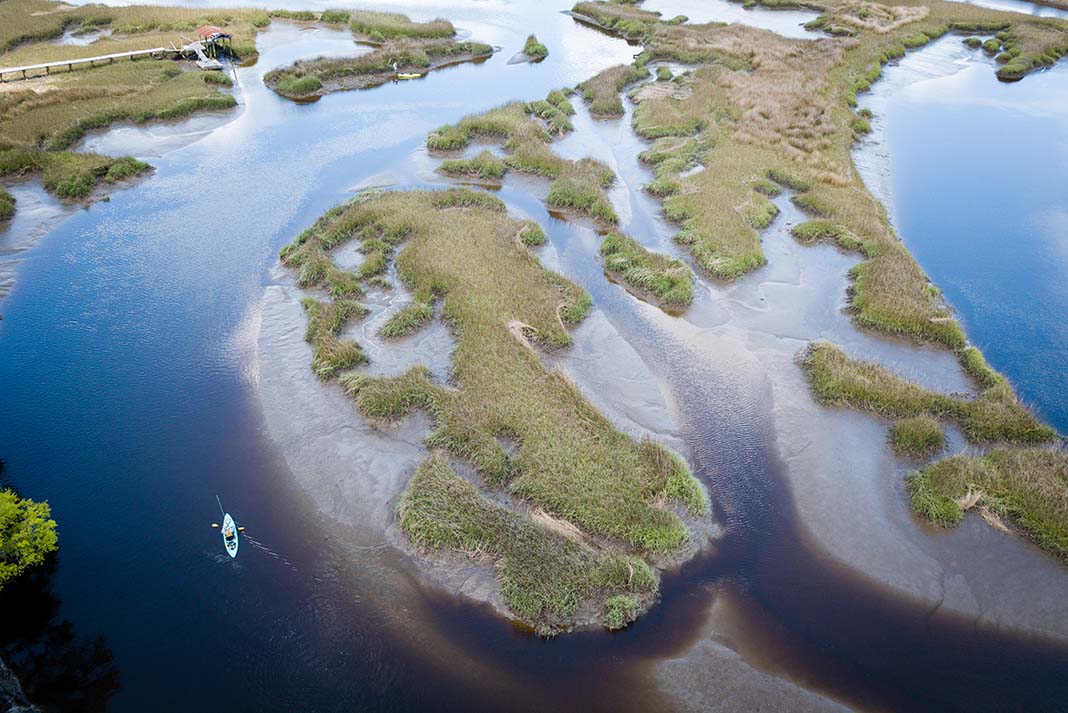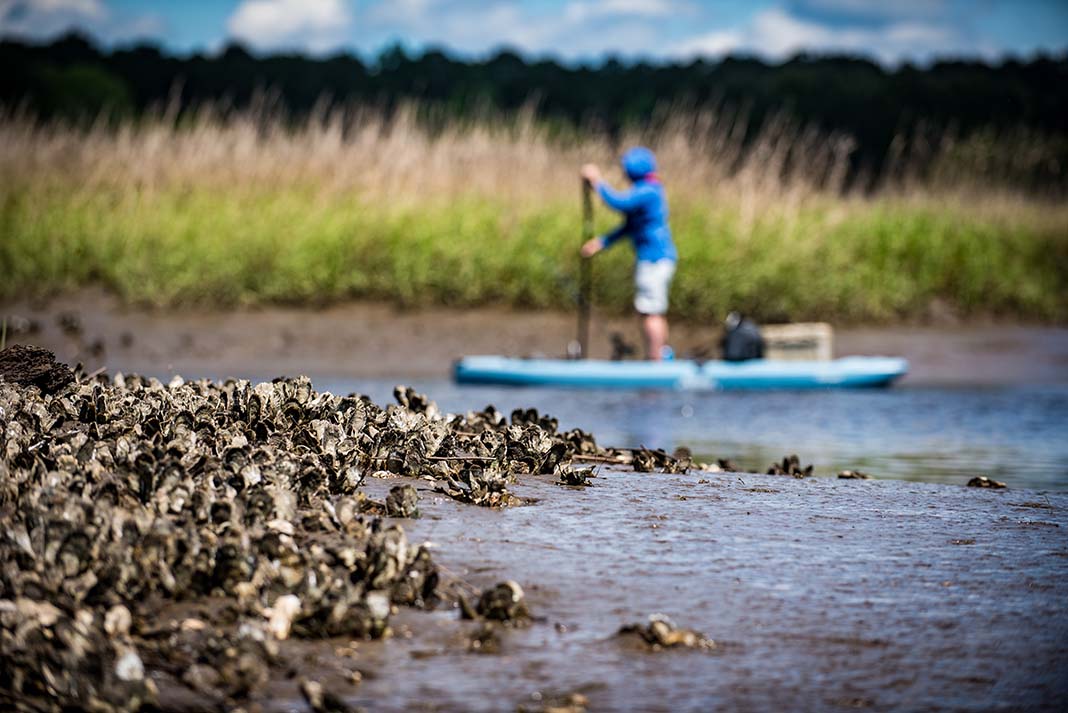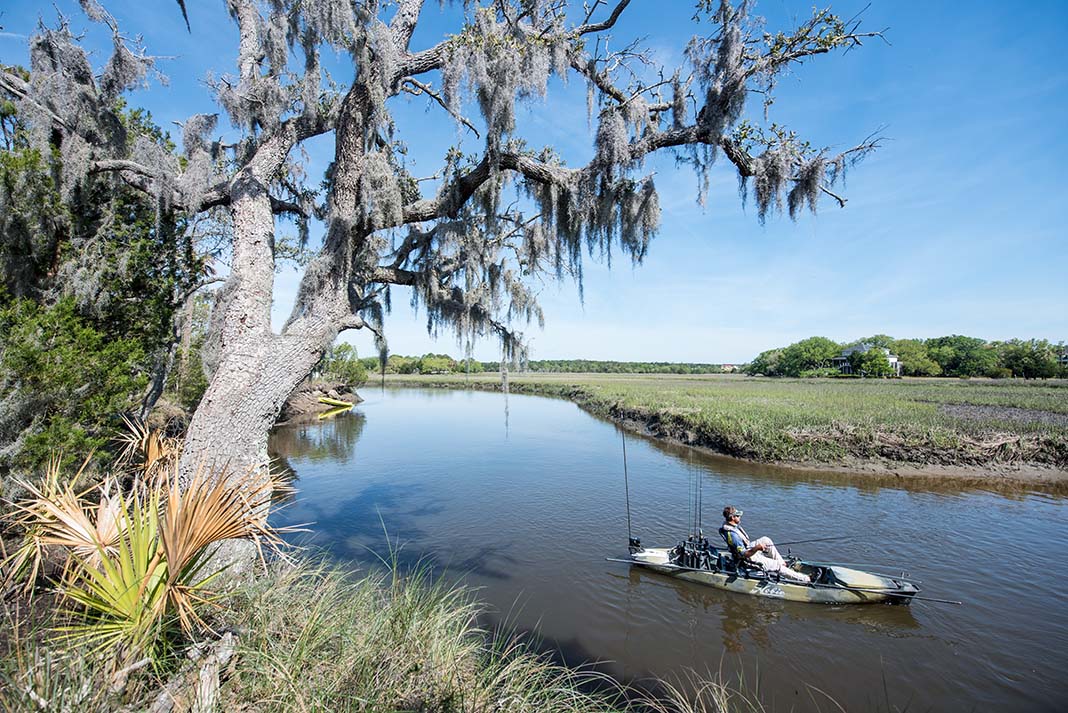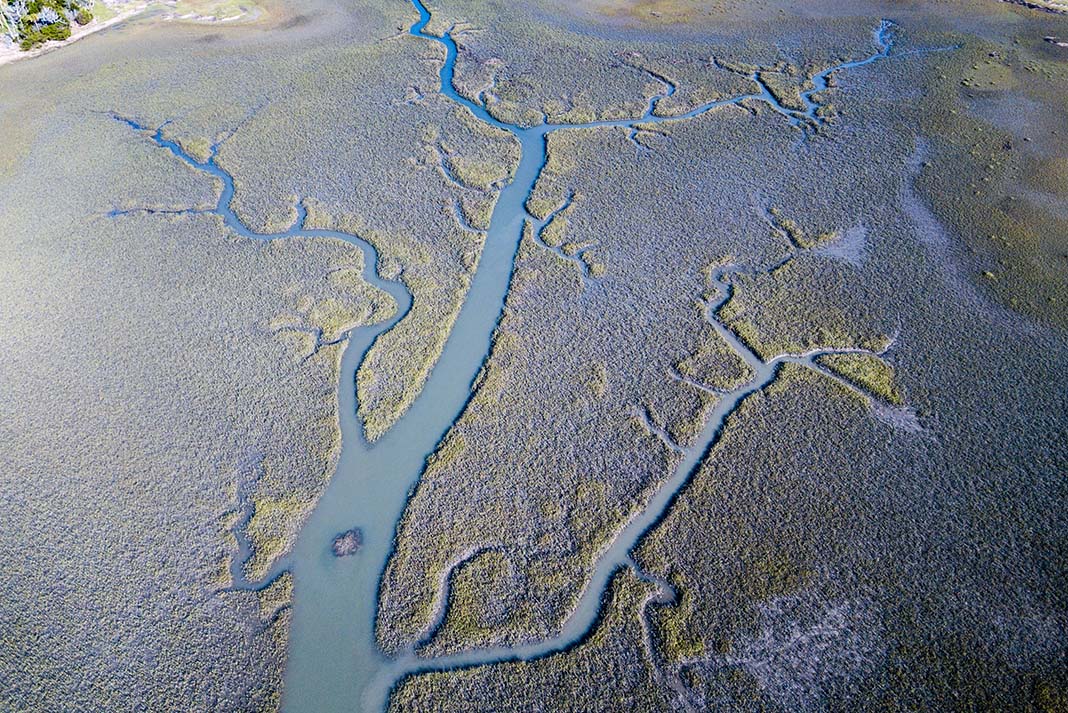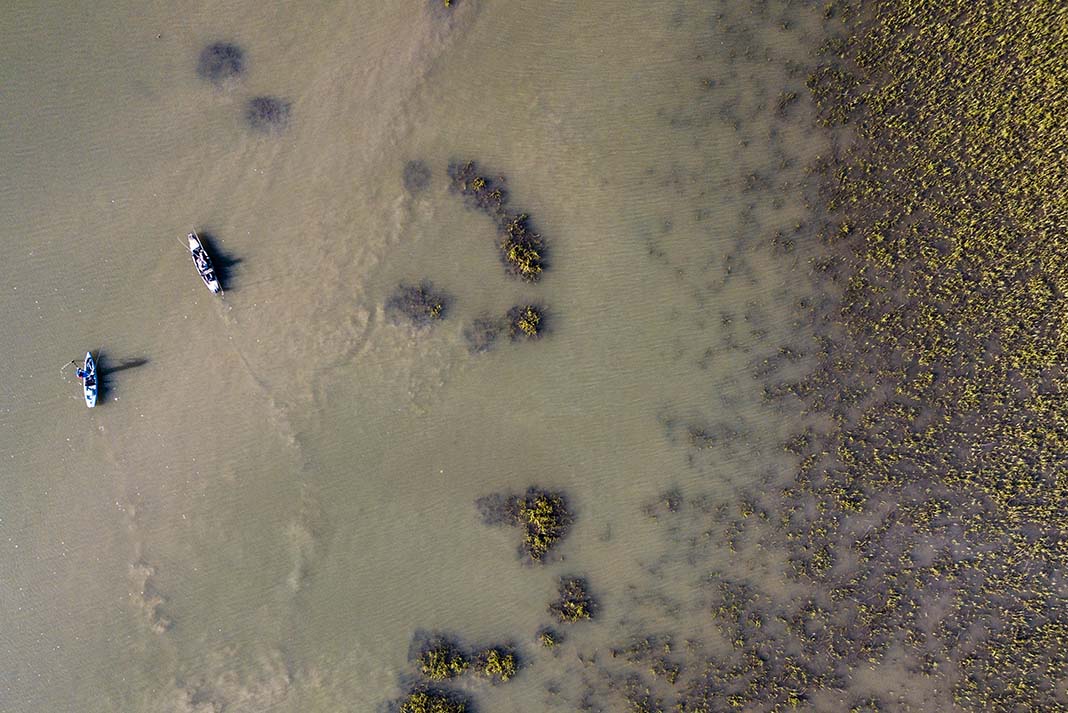Products You May Like
Charleston, South Carolina, is one of the most popular fishing destinations in America, and redfish are among its biggest draws. The confluence of swamp rivers and marsh rivers combines world-class freshwater fishing with world-class saltwater fishing. Kayak Angler contributor and pro photographer Aaron Black-Schmidt takes us on a virtual tour of the Low Country with one of the area’s favorite sons.
Captain Justin Carter is a full-time fishing guide and tournament-winning angler who specializes in skinny water fishing from kayak and boat. Living and fishing in the briny water of the southeast, Carter’s schedule is set by the tides. Every six hours the water rushes into the shallows before turning around and draining out to sea. Get the tides right and find fish on the feed. Miscalculate the flow and miss the bus.
How to Catch South Carolina Redfish
Sunrise seems to come faster on the East Coast. As a native of Washington State, I’m used to a slow, landlocked sunrise. In Charleston, South Carolina, the marsh flats do little to block the morning rays.
I rub sleep from my eyes and slide on my sunglasses before helping my friend Morgan Mason wrestle our Hobie fishing kayaks off the truck rack. Mason is a Montana-based outdoorsman and veteran writer for Backcountry Hunters and Anglers. He doesn’t seem sleep-deprived as he chats with our guide, Captain Justin Carter.
Captain Carter moves quickly to stow rods in the back of his Hobie Pro Angler 14. Despite the early hour, his easy movement tells of many similar mornings hardwired into his life as a pro guide and tournament angler. In addition to working on the water full time, Carter has scored International Fishing Association Kayak Angler of the Year and National Champion.
For Carter, this level of accomplishment requires a commitment to the environment he fishes. Fishing from a kayak, he is able to compile a more complete picture of the ecosystem and its relationship to the fish he targets. Carter tells me the kayak forces him to slow down and explore a smaller area than he would fish in his boat. So far this morning, I don’t see him slowing down.
Even with his practiced efficiency loading the kayaks and rigging the pedal drives, we can tell he’s in a hurry. As soon as his kayak is ready, he launches into the dark water and slams his pedal drive home.
Mason and I hustle to get our gear piled into our boats and set off. With the current rushing out, we chase the guide through narrow channels in the sea grass.
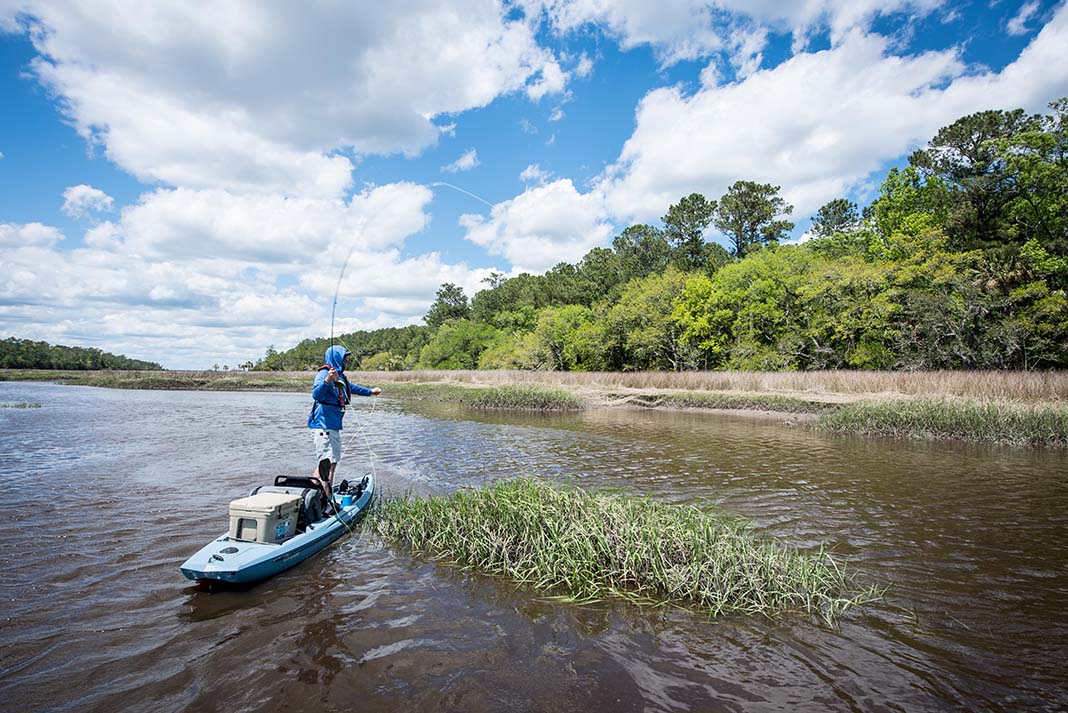
The hurry is warranted. I can tell the tide is dropping. In the expansive marshes and mudflats that stretch from Florida to the Carolinas, tide is everything.
In this part of South Carolina, the tide rises and falls four times each day. Every six hours, the current changes direction. First, it floods the creeks and marshes. Then the water drains back towards the ocean.
The regular inhale and exhale of millions of gallons of water dictates every coastal creature’s schedule, including the humans who live and work in the area.
Time Your Trip According to the Tides
As the sun rises and the water drops, we exit the main channel and pass an ancient native American midden, now called Rolby’s Island, and turn south into Copahee Sound.
Carter has his sights set on a small backchannel that is only accessible when the tide is high. Once into the channel, we will be trapped in the labyrinth until the tide rises.
The regular inhale and exhale of millions of gallons of water dictates every coastal creature’s schedule, including the humans who live and work in the area.
As we hurry through the marsh, Carter explains, “Tide influences everything I do and determines when and where I’m going to fish.”
We pedal past oyster beds rising from the dropping water like little castles. The guys suggest I put up my drone to get a better view. I pause my kayak to set up the launch while Carter and Mason continue down the creek.
The birds eye view is striking. The patterns of oyster reefs and sea grass stretch for miles. It’s not hard to see why pirates like Blackbeard used the Carolina coast as a hideout.
Mason and Carter have drifted out of sight, and it isn’t long before my handheld VHF crackles, “Uh, Justin wants to know how long you’re going to be.” It isn’t hard to hear the tension in Mason’s voice. “We got to hurry to get in the channel.”
Landing a drone in a drifting kayak isn’t easy. Eventually I get the little bugger down safely and catch up to the group.
We slip through the channel and make our way into a tight maze of mudflats and grass. Once we reach the channel, we drift into the quiet routine of casting and retrieving.
Carter uses a long pole to push his kayak. He tells me, “I love this thing. I can stand up to see further and it’s super stealthy.” Carter likes a telescoping pole extending to 17 feet long. “The longer pole helps me get good glides,” he demonstrates by pushing with the pole and sliding across the glassy water.
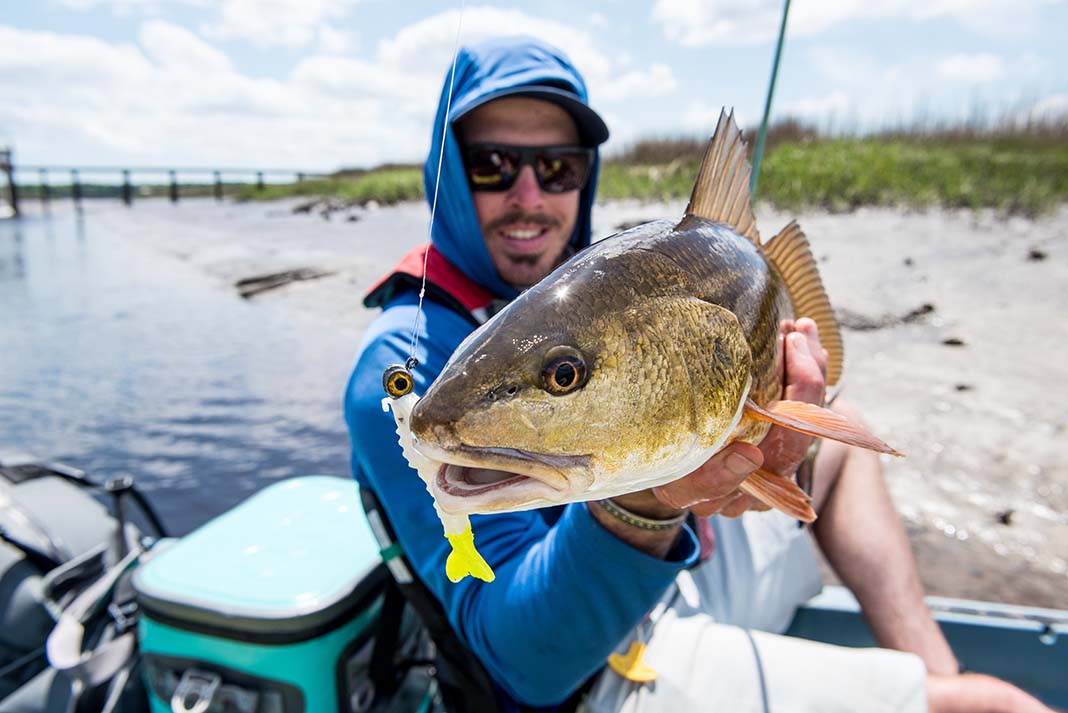
So far, the fishing hasn’t been great. Carter grunts as he reels in a small flounder. “Don’t tell my wife I caught this,” he says as he unhooks and flips the fish back into the water. “She loves these things.”
Cold Snap Knocks Down Redfish Numbers
We’re fishing for redfish. So far, we haven’t seen any. Carter explains the previous winter was very cold, with a catastrophic freeze decimating shallow areas such as the Copahee Sound. “We lost a ton of redfish, it may be a couple of years before the area gets right again.”
After a few hours fishing, the tide is on the rise. With the current behind us, we make our way back to the launch. Mason and Carter chat about fishing and we make plans to meet the next day at a new spot.
The next morning, when the sun pops up, we are on the Wando River. The horizon is hardly lit, and Carter catches a solid speckled trout. After he slips the silver and spotted fish back into the water, he pedals past me and says, “Today’s going to be a good day.”
We pedal quickly. Carter has a couple inlets he wants to hit before the weather gets too hot. The terrain here is different, with thick stands of cypress crowding the banks. Mason’s eyes go big as we pass the hindquarter of a deer floating in the water.
“Gator.” Carter flippantly delivers the one-word explanation. Mason and I look at each other for assurance. We don’t have alligators in Washington State so I’m a little shaken.
The tide is high and our kayaks slip over areas that will be high and dry in a few hours. “Redfish are an incredibly strong and versatile fish,” Carter explains how the winter’s cold snap may knock down the numbers, but it won’t wipe out redfish.
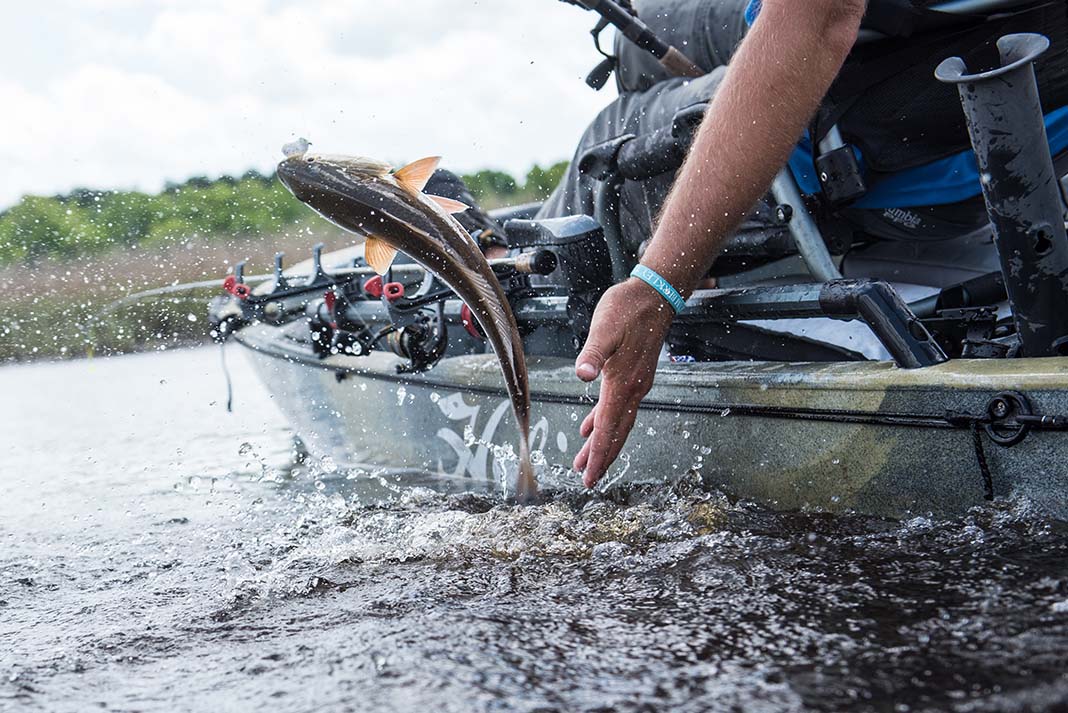
Carter lays out our plan. He says at high tide redfish follow bait into the grass. The predators set up ambush points near structure. “Redfish are one of the only big fish to literally crawl into backwater.” He continues to explain how shallow marsh grass protect the redfish from predators such as dolphins.
The savvy guide knows crabs are coming out of their mud dens and molting. “If you find the food, you’ll find the fish.” Carter recommends the Z-Man heavy-duty plastic crab. “Everything here has teeth. I’ve found that these baits hold up the longest,” he says as he flips a crustacean-shaped lure into the nearby grass.
With an emphatic splash, the first redfish hits Carter’s crab. I snap photos as the pro patiently works the redfish to his kayak.
Carter is standing and casting and concentrating. Both Mason and I stay back to him give him space as he glides his kayak deeper into the grass.
With an emphatic splash, the first redfish hits Carter’s crab. I snap photos as the pro patiently works the redfish to his kayak.
Redfish are famous for a dogged fight, and this fish lives up to its reputation. Carter works the reel to bring in line until he is forced to pause while the bulldog pulls against the reel’s drag. The give and take results in a golden-copper redfish in the angler’s lap. For the first time, I understand the draw for visiting South Carolina’s pungent marshes.
Fishing Gear and Rentals
Timeout Sport & Ski
Ask for Dave Hamilton to rent a fishing kayak.
675 Johnnie Dodds Blvd UNIT A, Mt Pleasant, SC 29464
843-388-6266
timeoutsports.netHaddrell’s Point Tackle
The best shop for lures, tackle and advice.
885 Ben Sawyer Blvd, Mt Pleasant, SC 29464
843-881-3644
hadrellspoint.comSuper stick push pole
Seewee Outpost
One-stop shop for gas, salted ham biscuits and bait. The shrimp salad sandwich is phenomenal.
4853 N Hwy 17, Awendaw, SC 29429
843-928-3493
seeweeoutpost.comTides PRO
Tides rule all. Get this $4 tide predictor app.
Fish, and Anglers, Flow with the Tide
As the tide drops, we make our way back to the mudflats. Carter explains how the tide can swing 10 feet. Marsh grass that is eye level at high tide will be six feet overhead six hours later.
He also shares how tide affects the fish. “A good bite may only last 30 minutes,” he says. Bait flows with the current and the bigger fish set up accordingly. “It sounds crazy, but I flow with the tide,” he says.
I can tell Mason is itching for a redfish. He normally targets steelhead and trout in western mountain rivers. Once the outdoorsman sees the redfish’s power and finesse, the angler in him is ready for a turn.
As the tide drops, we moved into the main river channel. Carter recommends fishing the area at low tide to learn the topography of the flats. “And low tide forces the fish to congregate in tighter areas,” he adds. By studying the area at low tide, he can predict where the fish will go when the tide floods.
Fortunately, Mason doesn’t have to wait long. He hooks a redfish that breaches the water several times as he works it to the boat. We take several photos before he slips the brassy fish back into the water.
As the midday sun heats up, we continue to explore the twisting waterways. Carter and Mason hunt for reds. Standing and searching, when they spot a telltale V-wake they make a long cast landing just in front of the fish. A couple flicks of the rod tip cause the lure to jump and get the red’s attention.
One of the aspects making Charleston a popular fishing destination is how easy it is to fish the area. Carter says, “There are fish everywhere, you just have to learn how to find them as the season and tides dictate.”
Food and Drink
Edmund’s Oast Brewing Co.
Serving up Captain Carter’s favorite brews.
1505 King St #115, Charleston,
SC 29405
843-718-3224Rodney Scott’s BBQ
Classic whole hog barbeque.
1011 King St, Charleston, SC 29403
843-990-9535Fleet Landing Seafood Restaurant
Try the whole fried flounder with apricot jam.
186 Concord St, Charleston,
SC 29401
843-722-8100
Charleston is a Year-Round Fishing Hotspot
Anglers can come to the Charleston area almost any time of year and expect to have good fishing. Redfish and speckled trout are found year-round. Cobia, tarpon and offshore fishing are best from spring to fall. “It’s no wonder the the area has exploded as a destination,” Carter says.
Mason and I were a perfect example. We were staying in Mt. Pleasant, a sleepy coastal town just north of Charleston. We rented rigged-up fishing kayaks from Timeout Sport and Ski and Hadrell’s Point Tackle helped us with advice on tackle and locations.
When we weren’t on the water, we checked out downtown Charleston. One of the south’s best historic and cultural destinations, Charleston’s riverfront combines antebellum architecture with all of the tourism trappings.
Mason and I enjoyed experiencing Charleston’s charming vibe. There was plenty to do day or night. And thanks to our time with Capt. Carter, we found out the fishing is really good, too.
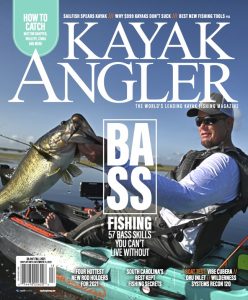
This article was first published in Kayak Angler Issue 46. Subscribe to Kayak Angler and get the magazine delivered to your front door. Download the Kayak Angler Magazine+ app to seamlessly glide between the digital archives, the latest articles and videos.
Riding the outgoing tide in search of redfish in South Carolina’s Low Country. | Feature photo: Aaron Black-Schmidt
